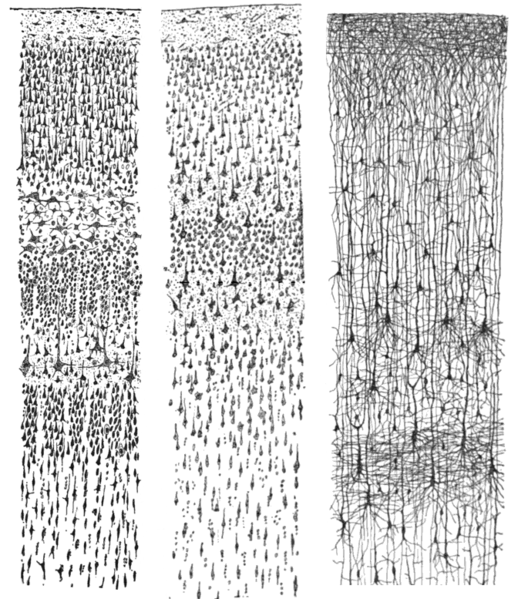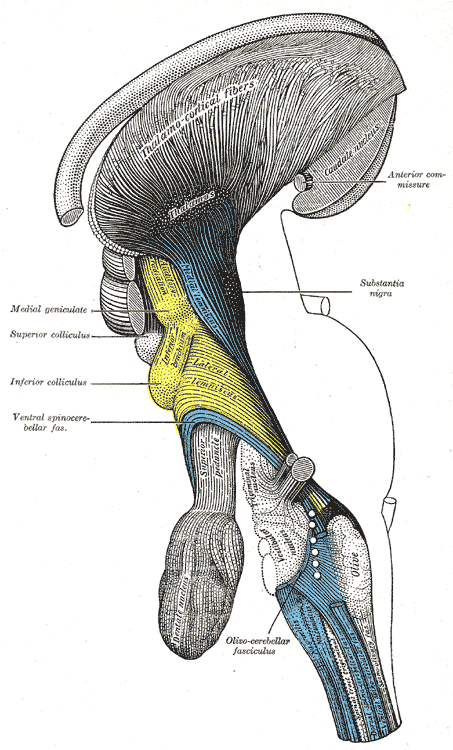The physical geometry of the brain has been well studied and gives important insights as to how information moves through it. Because, for now (your own) human brain is the only device we can be sure generates subjective consciousness (though almost all large brains almost assuredly generate a type of the pattern we'll discuss), it is what will be referenced when speaking of the physical geometry of thought. Conveniently, we know the rules the brain must play by, which makes some inferences possible. Henry Markram's work with the Blue Brain Project shows patterns that aesthetically (and, as we'll see much later, informationally) resemble the activity of real human cortical columns. In short, some points to note about the physiological brain's relation to cognition:
1. The brain is organized on several levels and in several dimensions. The cortical minicolumn (a collection of neurons organized "vertically" (inside to outside) in the brain, has been suggested as the smallest functional unit in the brain, outside of the well-understood behavior of individual neurons. Additionally, the cortex features vertical layering that appears to correlate with interconnection density (higher internal to each layer than between layers)
 |
| Depiction of cortical columns, with layering. Identification of specific neuron types is less important than the concepts of horizontal and vertical organization |
2. The cortex is organized into specialized "regions" associated with higher level functions such as vision, speech processing, speech generation, motor actions for each body part, and so on.
3. The cortex and thalamus are intimately connected, and moreso in humans than in any other mammal. This leads to a pattern of information processing that repeatedly enters and exits the thalamus and cortex. These "thalamocortical loops" form the basis of a physical pattern than is inherently recursive and continuous.
 |
| Note the fanning thalamocortical connections at the top. |
4. Long range horizontal connections between brain regions (spindle neurons, among others) allows for important high speed modifications of the overall pattern of the brain. Long range neural synchronization is a strong proxy for intelligence and creativity both between species and within individual humans.
5. Synapse action is delocalized, which leads to the important phenomenon of temporal synchronization. Because each synapse leaks neuron transmitters, and because an action potential is transmitted to all attached efferent neurons, adjacent neurons, even when not firing, tend to oscillate their voltage potential together. This is why "brain-waves" exist - neurons synchronize due to inherent oscillation, like cicadas chirping at night. Neurons that fire together most often (remember not all stimuli, only the sum of stimuli causes an "all-or-nothign" downstream action potential) have their synaptic connections strengthened, which is the primary theoretical basis of the self-modification of the brain.
Conclusions: The above is a lot to take in all at once, so in the interest of recapitulation...
The brain is organized as a series of neurons segregated into many smaller functional units. Units show both a hierarchical (serial, with respect to signal processing) architecture, as well as a parallel processing architecture. Neural activity proceeds through these columns, but has strong interconnectivity via the thalamocortical system. Along with the synchronization of activation times, this allows the structure of information flow to become looplike - cortex, thalamus, cortex, thalamus. This means the state of the brain has a continuous self similarity that has the potential to give rise to subjective consciousness.
Most Important References:
Next time: The hyperspatial structure of neural information processing, infinite extensibility of semantic meaning, and the relation of subjective consciousness to physical reality (if there is one at all).
http://mlkshk.com/r/2SGA
ReplyDeleteCicadas chirp during the day...Katydids/crickets chirp at night.
ReplyDeletePerhaps fireflies form a better analogy:
ReplyDeletehttp://www.youtube.com/watch?v=a-Vy7NZTGos